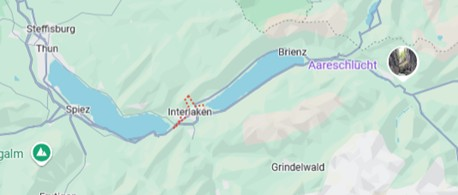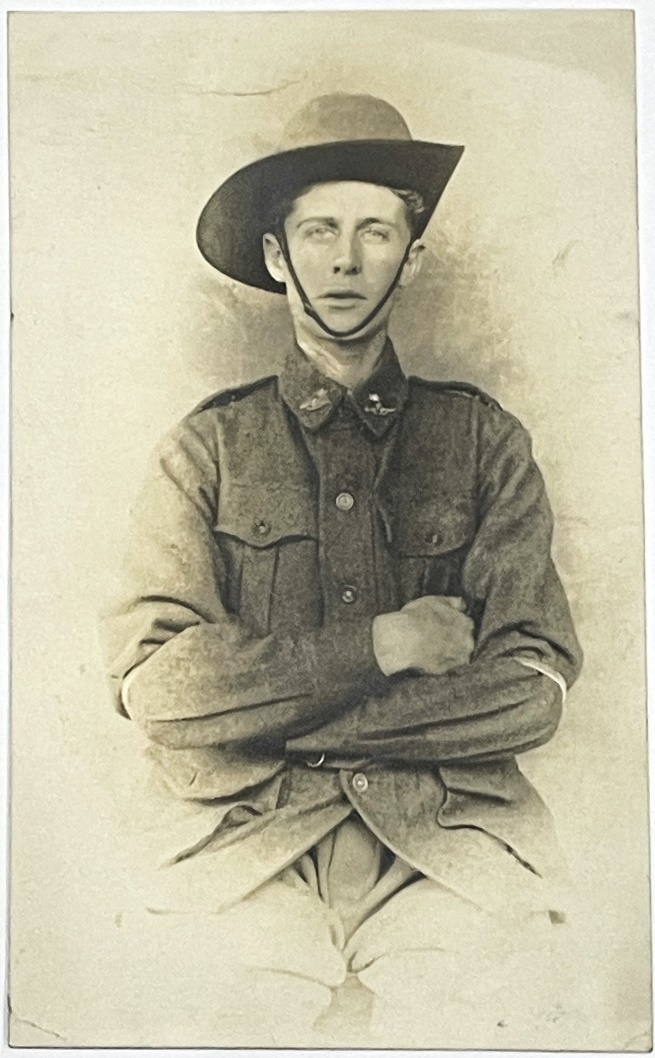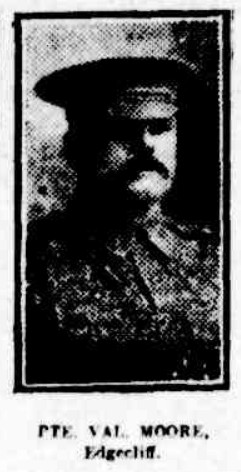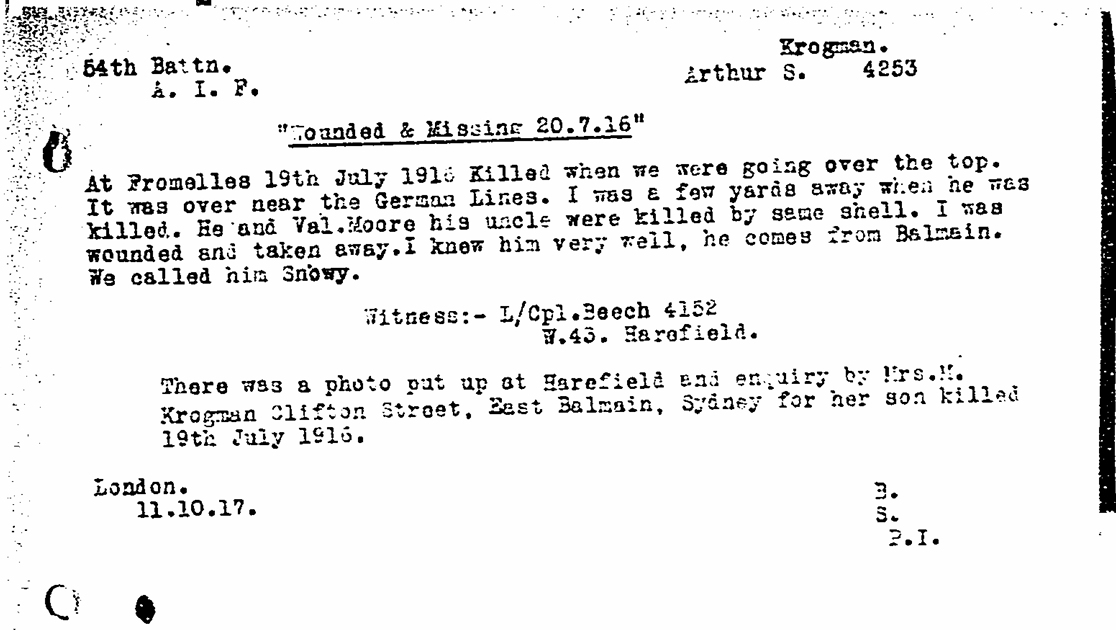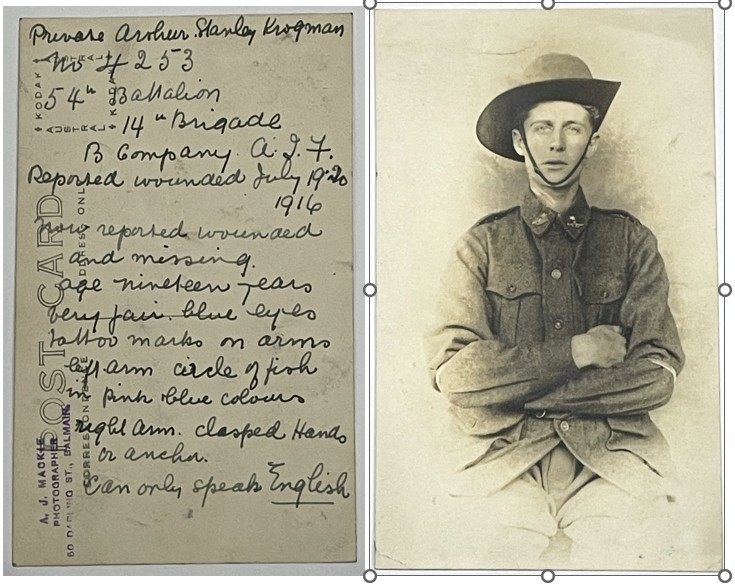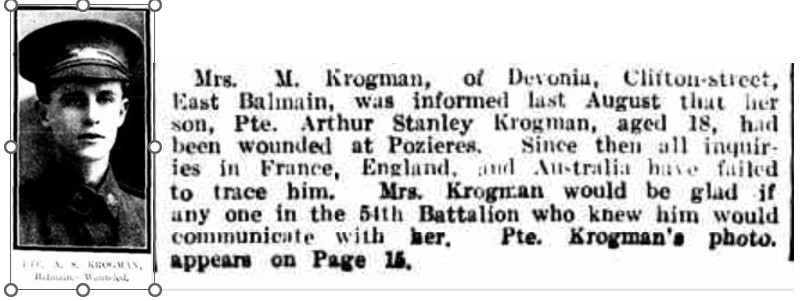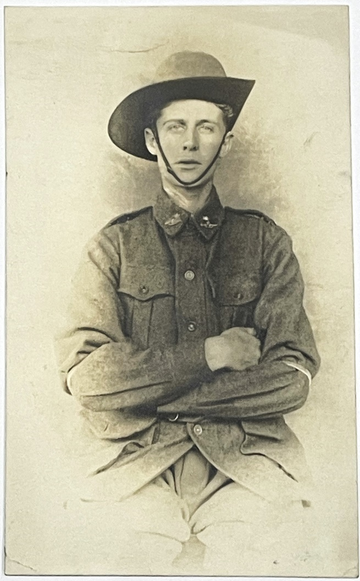
Arthur Stanley KROGMAN
Eyes blue, Hair light brown, Complexion fair
Arthur Krogman – Never Found, Never Forgotten
Can you help find Arthur?
Arthur Stanley Krogman was killed in action at Fromelles. Like over 1,000 other Australians lost in that single night, his body was never recovered, and he has no known grave.
In 2008, a mass grave was discovered at Pheasant Wood, containing the remains of 250 Australian and British soldiers recovered by the Germans after the battle. Since then, DNA has been used to identify many of the fallen. Family have come forward to help.
Please contact the Fromelles Association of Australia to find out more.
Early Life
Arthur Stanley Krogman was the son of Mabel May Worsnop 1874-1949 and Willy Henry Stanley Krogman 1870-1918. Willy was born in Leignitz, Prussia (now Legnica, Poland), on 25 April 1870. In 1896, he emigrated from Prussia to Adelaide, Australia, arriving on 27 October 1896. He was listed as a Gentleman Traveller. Arthur's mother, Mabel May Worsnop, was born in Adelaide on 28 May 1875, the daughter of Edwin Thomas Worsnop and Elizabeth Dove.
Mabel's grandfather was Thomas Worsnop, a notable town planner in Adelaide. Willy and Mabel married in Adelaide on 28 January 1897, shortly after Willy's arrival in Australia. Thomas Worsnop, Mabel's grandfather, was the Justice of the Peace who signed Willy's naturalization papers. Arthur was born in Interlaken, Switzerland, on 15 February 1898, a little over a year after his parents' marriage.
In 1904, when Arthur was six years old, he and his mother returned to Sydney, Australia. His father did not accompany them, and it appears that the marriage had ended. Records indicate that both Willy and Mabel identified as single from this point forward. The reason for the separation remains unknown. Upon returning to Sydney, Arthur and his mother were close to Mabel's parents. In 1911, Mabel began working as a Salon Stewardess with the Adelaide Steamship Company, which required her to travel for months at a time.
At the age of 16, Arthur joined his mother and her friend, Valentine Moore, at the Adelaide Steamship Company, working as a probationer. Records from his first voyage confirm his birth in Switzerland and that Valentine Moore was on the same voyage. Known affectionately as “Snowy” for his fair hair, Arthur was described as a cheerful young man devoted to his mother.
Off to War
When the First World War broke out, Arthur was still too young to enlist. His close family friend and colleague, Valentine Moore, enlisted on 27 August 1915. Not wanting to be left behind, Arthur enlisted less than three weeks later, on 14 September 1915, at just 17 years of age. To do so, he lied about his age on his enlistment papers, claiming he was 18, and gave his birthplace as Dulwich Hill, Sydney, rather than Interlaken, Switzerland.
This change may have been to avoid prejudice against his German and Swiss heritage during wartime. Arthur was assigned to the 13th Reinforcements of the 1st Battalion. On 20 December 1915, he and Valentine Moore embarked from Sydney aboard HMAT A60 Aeneas, bound for Egypt. Initially, they expected to join the Gallipoli campaign, but by the time they arrived, the Allied forces had already evacuated. Instead, they trained at Tel el Kebir in Egypt. There, Arthur was transferred to the 54th Battalion, alongside Valentine. In June 1916, Arthur and his battalion embarked from Alexandria for France.
They disembarked at Marseilles on 29 June after a ten-day voyage via Malta and then travelled by train to Hazebrouck, 30 km from Fleurbaix. By early July, Arthur and his comrades were billeted in barns, stables, and private homes in Thiennes, adjusting to life on the Western Front and training for the battles ahead. Training now included gas mask drills and exposure to artillery shelling. The battalion war diary recorded that these tests were intended to:
“inspire the men with great confidence.”
On 10 July they moved to Sailly-sur-la-Lys, entering the trenches for the first time on 11 July. The health and spirit of the troops was reported as good. After a few days in the trenches, they moved back to billets in Bac-St-Maur. Major Roy Harrison, writing home on 15 July, reflected somberly on what lay ahead:
“The men don’t know yet what is before them, but some suspect that there is something in the wind. It is a most pitiful thing to see them all, going about, happy and ignorant of the fact, that a matter of hours will see many of them dead; but as the French say ‘C’est la guerre’.”
Battle of Fromelles
The 54th Battalion’s first major engagement on the Western Front was the Battle of Fromelles. On 19 July 1916, Arthur and Valentine went into battle. The attack was originally planned for 17 July but delayed due to weather. By 19 July, the men were back in the trenches, ready to advance. The 54th’s main objective was to take the trenches to the left of a heavily armed, elevated German position known as the ‘Sugar Loaf’.
This stronghold dominated the battlefield with its machine gun emplacements. If the Sugar Loaf could not be taken, the 54th and neighbouring battalions would face devastating enfilade fire and counterattacks. Neither Arthur nor Valentine were ever seen alive again after they went “over the top”. Fellow soldiers later gave these accounts of their fate.
Private R. H. Williams, 4252, 54th Battalion:
“At Fromelles 19th July 1916: Killed when we were going over the top. I was a few yards away when he was killed. He and Val Moore his uncle were killed by same shell. I was wounded and taken away. I knew him very well, he comes from Balmain. We called him Snowy.”
Valentine’s fate was described by Private R. H. Williams, 4252, 54th Battalion:
“He was killed alongside me in the charge on July 19th at Fleurbaix, just in front of the German barbed wire. The body had to be left there as we went on into the German trenches.”
At 5.50 PM on 19 July, the men began to leave their trenches in four waves – half of A and B Companies in the first two waves, and half of C and D Companies in the third and fourth. The first waves moved into No-Man’s-Land and lay down, waiting for the British bombardment to lift. At 6.00 PM, the German lines were rushed. The 54th advanced under heavy artillery, machine gun, and rifle fire. The 14th Brigade War Diary recorded that the artillery preparation had been effective, noting:
“very few living Germans were found in the first and second line trenches.”
Some of the captured trenches were little more than water-filled ditches needing immediate fortification. The 54th linked up with the 53rd Battalion on their right, and with the 31st and 32nd further along the line. However, the 60th Battalion on their far right was unable to advance due to intense fire from the Sugar Loaf, leaving their flank dangerously exposed. Throughout the night, the 54th attempted to hold their position against relentless German counterattacks. Their retreat the next morning was chaotic and deadly. The exposed flank allowed German troops to infiltrate trenches behind the 54th and 53rd Battalions, forcing the Australians to repel attacks from the rear as they withdrew.
By 7.30 AM on 20 July, the shattered remnants of the 54th had been pulled back to Bac-St-Maur, five kilometres from the front. In less than 24 hours, of the 982 soldiers who left Egypt, 73 were killed, 288 wounded, and 173 reported missing. When Charles Bean, Australia’s official war historian, visited the battlefield two and a half years later, he observed bones, torn uniforms, and Australian kit still strewn across the ground – a haunting testament to the ferocity of the battle. Ultimately, 172 soldiers of the 54th were killed in action or died of wounds, with 102 listed as missing.
After the Battle
In the days following the Battle of Fromelles, there was confusion about Arthur’s fate. Initially, reports suggested he had been wounded rather than killed. A cable was sent to his mother, May Krogman, in Australia, informing her that Arthur was wounded in action. This gave her hope that her only child was recovering somewhere in a hospital. Valentine Moore’s sister, Nora, also sought information and received a letter dated 23 August 1916, confirming Arthur was listed as wounded. For weeks, the family clung to this hope. However, no further updates arrived.
As time passed with no news, May wrote to the Army again in November, desperate for any information. The Australian Red Cross Wounded and Missing Enquiry Bureau then became involved. Their files record correspondence between the Army and May, as well as eyewitness accounts from soldiers. These confirmed that Arthur and Valentine had been killed by the same shell on 19 July 1916, during the attack at Fromelles. In a poignant letter written in 1917, May described Arthur, her only child, as “her all.” She enclosed a photograph of him, with a handwritten description on the back.
Her letter reads:
Devonia, Clifton Street, East Balmain, Sydney, New South Wales, AustraliaApril 9th, 1917
The Manager, Australian Red Cross, London
Dear Sir,
Will you pardon the liberty I am taking, but I am trying to trace my son, my only child, who was reported wounded July 19th & 20th 1916 in France, and is now reported wounded and missing. The particulars are –
Private Arthur Stanley KrogmanNo. 4253B Company54th Battalion14th BrigadeAustralian Imperial Forces.
Nineteen years of age. Very fair hair. Blue eyes. Tattoo marks on both arms – one arm circle of fishes entwined in pink and blue colouring, the other arm clasped hands or hearts. We are not quite sure which. He was known as the “Babe”. His friends say he was wounded either in the neck or shoulder, but as no one can trace him, I think he may be a prisoner or suffering from loss of memory.
I am enclosing a photo of my son with description written on the back. If you could insert [this] in some English paper for me or help me in some way to trace him I should be eternally grateful. I am a widow. He is my all.
Thanking you in anticipation, I remain
Yours faithfully,May Krogman.
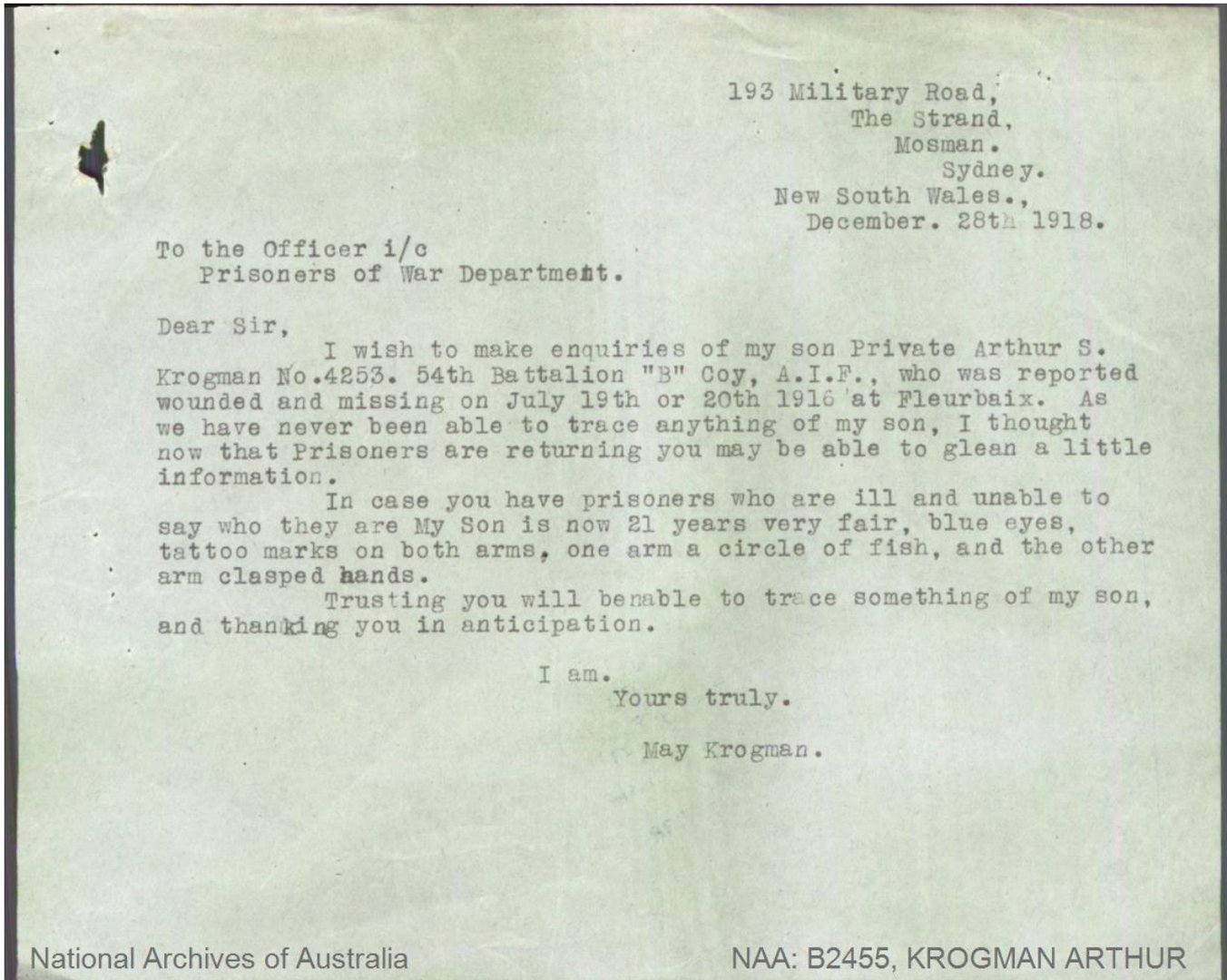
Despite official confirmation of his death, she continued to search for years, hoping that he may have been taken prisoner. Her hopes were never realised, and no trace of Arthur’s body was ever found. She never gave up hope of him one day being found.
May never remarried or had other children. After the war, she opened the Victory Café in Sydney with one of Valentine Moore’s sisters. For at least ten years after Arthur's death, May Krogman and Valentine Moore's sister, Nora, placed "In Memoriam" notices in the Sydney Morning Herald to remember Arthur and Valentine.
Sydney Morning Herald, 20 July 1918:
KROGMAN. – In loving remembrance of my dear son, Arthur S. Krogman, who was killed in action, France, July 19–20, 1916.Inserted by May Krogman.
KROGMAN. – In loving memory of our dear grandson, Arthur S. Krogman, who was killed in action, July 19–20, 1916.Inserted by E. T. and E. Worsnop.
KROGMAN. – In loving memory of Pte. Arthur Stanley Krogman, now reported killed in action, Fleurbaix, July 19–20, 1916 (previously reported wounded and missing).Inserted by Mr. and Mrs. Wm. Ogilvie.
Arthur is commemorated at:
- VC Corner Cemetery Memorial, Fromelles (No. MR 7)
- AWM Roll of Honour
Finding Arthur
In 2008, a mass grave was found at Fromelles, containing 250 Australian and British soldiers buried by the Germans after the battle. Through DNA matching with family donors, as of 2024, 180 of these soldiers have been identified, including 28 men from the 54th Battalion. Arthur’s remains have not yet been identified, but the grave was in the vicinity where he and his uncle
Valentine Moore were killed by the same shell. Recent research has confirmed that some of Arthur’s family have come forward to provide DNA samples.
DNA samples are being sought for family connections to
| Soldier | Arthur Stanley KROGMAN (1898–1916) b Interlaken, Switzerland, |
| Parents | Willy Henry Stanley Krogman (1870–?) and Mabel May Worsnop (1875–1960) |
| Siblings | None – only child |
| Grandparents | ||||
| Paternal | Henry Ernest Krogman and unknown, Leignitz (now Legnica, Poland) | |||
| Maternal | Edwin Thomas Worsnop (1845–1901) and Elizabeth Dove (1852–1926), of Adelaide, SA |
Links to Official Records
Seeking DNA Donors

Contacts
(Contact: carla@fromelles.info or geoffrey@fromelles.info).
(Contact: army.uwc@defence.gov.au or phone 1800 019 090).
Donations
If you are able, please contribute to the upkeep of this resource.
(Contact: bill@fromelles.info ).
